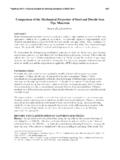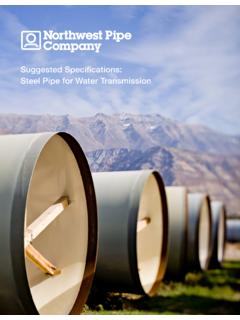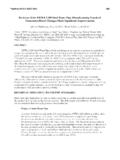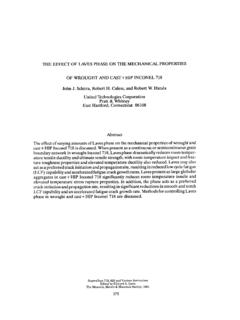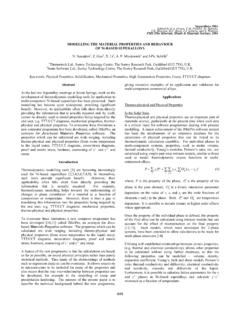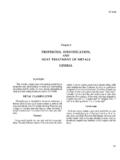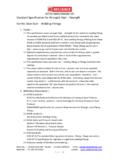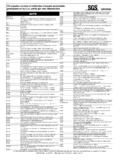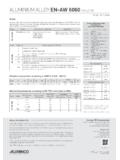Transcription of Comparison of the Mechanical Properties of Steel …
1 Comparison of the Mechanical Properties of Steel and Ductile Iron Pipe Materials Brent Keil1, Jack Devletian2 ABSTRACT Water infrastructure engineers commonly evaluate a variety of pipe materials to determine the most appropriate solution for a particular application. Occasionally engineers inappropriately apply identical structural design criteria for both Steel and ductile iron pipe (DIP). While similarities do exist, there are substantial differences in the material Properties that make their structural designs unique.
2 The applicable AWWA standards and design manuals are evidence of such variances. To demonstrate the distinguishing Mechanical Properties of Steel and ductile iron, large diameter samples were gathered, cut, and subjected to Mechanical property testing. A review of the results will validate the existence of distinct material Properties and clearly indicate the need for unique design practices that should not be modified or comingled. The Mechanical property differences between Steel and ductile iron and the implications to applicable AWWA design criteria are discussed.
3 INTRODUCTION Engineers are, today more than ever, pushed to simplify and standardize designs and design procedures. At times, for the sake of perceived technical or commercial fairness, these considerations get inappropriately used in the structural design of different pipe products, as has been seen in some pipe specifications produced. Although certain aspects of pipe design can be standardized such as equal performance requirements based on design pressures, there are limits to what can be done with the structural design once performance limits are established.
4 Different products have different inherent physical characteristics that must be uniquely accounted for in their particular design. This paper evaluates the similarities and differences in Mechanical Properties of two common pipe products used in water transmission pipelines, ductile iron pipe and Steel pipe. History of the base materials used is explored, from a view point of their structural functioning. Mechanical testing results for the two pipe materials are reported. Discussions on the differences in application of the AWWA structural design criteria for each material are presented to show why the differing approaches are appropriate.
5 HISTORY AND CLASSIFICATION OF CAST IRON AND STEELS History - The production of iron and Steel has a long history, with the first recorded working of iron dating back to 1500 BC. The iron was heated, hammered and worked, but by itself iron was softer than bronze. By 1100 BC, it had been discovered that by reheating the iron in a furnace with charcoal, some of the carbon was transferred to the iron, resulting in hardening of the metal. The 1 , Corporate Chief Engineer, Northwest Pipe Co.
6 , 5721 SE Columbia Way, Suite 200, Vancouver, WA 98661, Tel: (360) 397-6250, Email: 2 , Professor - Materials Science Group, Mechanical and Materials Engineering Dept., Portland State University, PO Box 751, Portland, OR 97207, Tel: (503) 725-2986, Email: 1301 Pipelines 2011: A Sound Conduit for Sharing Solutions ASCE 2011 metal was hammered and worked to remove cinders and slag, and the material compacted. This produced wrought iron (wrought meaning worked) and had a carbon content of just to percent (Spoerl 2004). Quenching the metal in water further increased the hardening.
7 These processes eventually replaced copper and bronze as the preferred metal for weapons because the metal was harder, yet the edge of a blade could still be honed and sharpened. This new material was the origins of Steel . It was also the start of the Iron Age, but furnaces were not yet hot enough to actually melt iron; this would take another 500 to 600 years to accomplish. Around 500 BC, the Chinese created a furnace capable of melting iron which required about 2800 F. Up to then, furnaces could melt copper at temperatures of about 2000 F, but were incapable of reaching the higher temperatures needed for iron.
8 At these high temperatures, iron also would draw in large quantities of carbon into the matrix, creating cast iron with carbon ranging from 3 to percent. This high carbon content made cast iron hard but brittle and it could not be forged (heated and shaped by hammer blows). It would be over another thousand years before the western world would develop the process to melt iron. By then the Chinese were using cast iron as structural elements. Up to the 1700 s, casting iron was still a limited process, whereby large quantities of charcoal were needed to produce the iron.
9 It was then discovered that coke (coal baked to remove impurities) could be used instead of charcoal. The result was a major improvement in cast iron production. Other innovations were occurring as well. The blast furnace had been developed, a chimney-like structure where the combustion was intensified by blasting air pumped through alternating layers of charcoal, flux, and iron ore. Molten iron was poured through a series of lateral sand troughs, which resembled piglets suckling, giving it the name pig iron. By the late 1700 s, pig iron was being refined in puddling furnaces, which allowed for excess carbon to be oxidized out of the mix.
10 As the carbon oxidized out, the melting point of the iron would rise and bits of hardened metal would form on the surface. Skilled workers called Puddlers would remove the bits and place them together to be hammered in a forge. The wrought iron was then run through a rolling mill to produce sheets or rails. Development of Steel Manufacture - Steel has a carbon-content lower than cast iron, but at the time, it was much harder to make due to the difficulty of controlling the carbon content during processing. Wrought iron has little carbon, enough to make it harder than pure iron, but still malleable.
